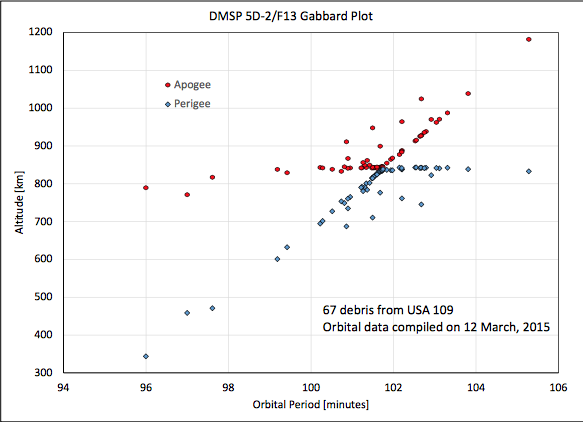
Figure 1. A Gabbard plot showing the dispersion of 67 debris from the USA 109 breakup on 03 February 2015. Approximate epoch is 12 March 2015On 03 February 2015, at approximately 17:40 UT, a Defense Meteorological Satellite Program (DMSP) spacecraft experienced a single breakup event, resulting in the creation of a new debris cloud. This spacecraft is part of a series of satellites used to monitor meteorological, oceanographic, and solar-terrestrial physics for the United States Department of Defense.
[SatNews] Despite in-depth studies, sometimes the answer eludes even the most dedicated.
Orbital Debris Quarterly News from NASA re: Recent Breakup of a DMSP Satellite
Known as USA 109 (International Designator 1995-015A, U.S. Strategic Command [USSTRATCOM] Space Surveillance Network [SSN] catalog number 23533) and also as DMSP 5D-2/F13, this ~850 kg spacecraft was launched on 24 March 1995 in a nearly circular orbit at an altitude of about 840 km and an inclination of 98.75o.
By 12 March 2015 a total of 67 debris had been officially cataloged by the U.S. Space Surveillance Network (SSN), but many more are being tracked that may eventually be added to the catalog, possibly pushing the total number well above 100.
Figure 1 illustrates the relatively wide dispersion of the debris, extending more than 300 km above and below the pre-breakup orbit. The debris cloud is mostly symmetric in altitude, with a similar number of debris thrown into orbits with longer periods than the parent body as those with shorter periods. Similarly, about half the debris were put into orbits with inclinations higher than the parent spacecraft, and half into orbits with lower inclinations. Unfortunately, this altitude regime is particularly cluttered with debris from a large number of historical breakups. The event occurred at a high enough altitude that much of the debris from this breakup will remain in orbit for many decades.

Figure 2. An artist’s conception of the DMSP 5D-2 spacecraft in orbit. Figure courtesy of the Office of the Historian, National Reconnaissance Office
Because the spacecraft was still active when the event occurred, telemetry data from the spacecraft was available to assess the cause of the breakup. While the anomaly investigation is ongoing, preliminary analysis indicates that this was an explosion of one of its Ni-Cd batteries.
Note that on 15 April 2004, a similar DMSP satellite, USA 73 (DMSP 5D-2/F11, 1991- 082A, 21798) broke up due to unknown reasons (see ODQN, vol. 8, issue 4, October 2004), producing a comparable size debris cloud (84 debris currently catalogued). That spacecraft, illustrated in Fig. 2, had been decommissioned and was no longer functional at the time of breakup, so no telemetry was available to assess the cause. However, the batteries had been discharged at the time of decommissioning, so a battery explosion was ruled out.

